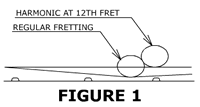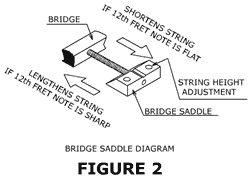
INTONATION, HARMONICS AND OTHER FANCY STUFF
By huskybones
Hello there! Here we are again in the back row of the BASSLAND classroom about to engage in another topic that will never be of any use to you when you grow up. Ahh, who wants to do that anyway?
This time I'm going to address something that I get a lot of questions about as a teacher: What is intonation? What do these things on the bridge do? Don't I need a strobe tuner? Well, I'm going to pass on some information so that you can try it out for yourselves. See if things don't sound a little more in tune.
First a little background information could be called the amount of "in tune-ness" your instrument has as you play in different areas. If you've tuned in one position but when you play on another part of the neck it sounds out, then the intonation may need adjustment. A stringed instrument is never perfectly in tune at every place on the neck, at the same time. There will always be some imperfection. An old Greek guy named Pythagoras discovered this scientifically about 2,500 years ago. I think he also invented the triangle. Well anyway, to spread out the imperfection and make it less noticeable, the bridge of your instrument is equipped with some method of lengthening or shortening the strings. You may have an adjustment for each string or maybe every two strings but the idea is the same. What we do then is use a tuner to check tuning, the saddles to adjust, and make the 12th fret harmonic sound the same as the 12th fret note.
With regard to the 'strobe tuner' question, I say that maybe you need one maybe you don't. It depends on how accurate you want/need to be. Is that clear enough? Imagine the space between the 11th and 12th fret divided into a hundred parts (called 'cents' by the way). A $300 strobe tuner that can measure down to 1/3rd of a cent may give you what your looking for. A cheaper ($20-$25) tuner may only get you to plus or minus 5 cents, but that may be fine for your ears. I use a regular $80 tuner and my ears for my intonation settings and it works fine for me. So listen and decide for yourself.
One last thing here is the "harmonic". It's a technique for getting really high notes out of your guitar/bass. Put a finger (fret hand) on the string right on top of the 12th fret (see Fig. 1) but don't push down, just touch it. Then pluck hard with the other hand in the area of the bridge. The note should ring out. If it doesn't, check your fret hand position, pluck a little harder, or get some new strings.

OK, here's the method I use to set the intonation. Remember to be patient, experiment, and make the adjustments slowly:
 If you're going
to put on new strings, which I recommend, do this first and adjust the
saddle height if necessary, though it probably won't change unless you're
using a new string gauge.
If you're going
to put on new strings, which I recommend, do this first and adjust the
saddle height if necessary, though it probably won't change unless you're
using a new string gauge.
 Tune your instrument
to "concert pitch" or the normal string pitches on your tuner.
Tune your instrument
to "concert pitch" or the normal string pitches on your tuner.
 Do all of your
tuning checks with your guitar in playing position. The tension on the
neck is different when it's lying down flat.
Do all of your
tuning checks with your guitar in playing position. The tension on the
neck is different when it's lying down flat.
 Play the 12th fret
harmonic on a string and check the tuning. You'll want to have the treble
up to make sure the harmonic comes out, and hold the other strings quiet
so the tuner doesn't get confused. Tune it up if you need to.
Play the 12th fret
harmonic on a string and check the tuning. You'll want to have the treble
up to make sure the harmonic comes out, and hold the other strings quiet
so the tuner doesn't get confused. Tune it up if you need to.
 Play the fretted
note at the 12th fret and check tuning. If the note is flat, shorten the
string. If the note is sharp, then lengthen it. (See figure 2)
Play the fretted
note at the 12th fret and check tuning. If the note is flat, shorten the
string. If the note is sharp, then lengthen it. (See figure 2)
 Check harmonic
and fretted note again and adjust until they read the same note.
Check harmonic
and fretted note again and adjust until they read the same note.
 Repeat for each
string.
Repeat for each
string.

**NOTE FOR GUITAR PLAYERS**
The intonation adjustment described above works on any stringed instrument basically. But in an effort to cover more I consulted with a guitar repair guru. Friggin Harvey's guitarist Tony K., had a few things to add. Masking tape stuck lightly on the strings will cut out unwanted sound. A good setting for tuning checks would be the neck pickup with the tone set halfway. Tony also uses a strobe tuner.
Keep in mind that there are other factors that effect the instrument tuning. The height of your action, fretting pressure, and whether or not you're 'detuned' overall, play a part.
Another consideration is the age of your strings. If you like old bass strings, just keep in mind that you may not be able to tune as accurately. So, if your axe is reasonably playable, then the steps above should get you pretty close. If not see a qualified guitar tech about a 'setup'.
That's it for this time. I hope this proves useful.
-hb
By huskybones
Hello there! Here we are again in the back row of the BASSLAND classroom about to engage in another topic that will never be of any use to you when you grow up. Ahh, who wants to do that anyway?
This time I'm going to address something that I get a lot of questions about as a teacher: What is intonation? What do these things on the bridge do? Don't I need a strobe tuner? Well, I'm going to pass on some information so that you can try it out for yourselves. See if things don't sound a little more in tune.
First a little background information could be called the amount of "in tune-ness" your instrument has as you play in different areas. If you've tuned in one position but when you play on another part of the neck it sounds out, then the intonation may need adjustment. A stringed instrument is never perfectly in tune at every place on the neck, at the same time. There will always be some imperfection. An old Greek guy named Pythagoras discovered this scientifically about 2,500 years ago. I think he also invented the triangle. Well anyway, to spread out the imperfection and make it less noticeable, the bridge of your instrument is equipped with some method of lengthening or shortening the strings. You may have an adjustment for each string or maybe every two strings but the idea is the same. What we do then is use a tuner to check tuning, the saddles to adjust, and make the 12th fret harmonic sound the same as the 12th fret note.
With regard to the 'strobe tuner' question, I say that maybe you need one maybe you don't. It depends on how accurate you want/need to be. Is that clear enough? Imagine the space between the 11th and 12th fret divided into a hundred parts (called 'cents' by the way). A $300 strobe tuner that can measure down to 1/3rd of a cent may give you what your looking for. A cheaper ($20-$25) tuner may only get you to plus or minus 5 cents, but that may be fine for your ears. I use a regular $80 tuner and my ears for my intonation settings and it works fine for me. So listen and decide for yourself.
One last thing here is the "harmonic". It's a technique for getting really high notes out of your guitar/bass. Put a finger (fret hand) on the string right on top of the 12th fret (see Fig. 1) but don't push down, just touch it. Then pluck hard with the other hand in the area of the bridge. The note should ring out. If it doesn't, check your fret hand position, pluck a little harder, or get some new strings.

OK, here's the method I use to set the intonation. Remember to be patient, experiment, and make the adjustments slowly:

**NOTE FOR GUITAR PLAYERS**
The intonation adjustment described above works on any stringed instrument basically. But in an effort to cover more I consulted with a guitar repair guru. Friggin Harvey's guitarist Tony K., had a few things to add. Masking tape stuck lightly on the strings will cut out unwanted sound. A good setting for tuning checks would be the neck pickup with the tone set halfway. Tony also uses a strobe tuner.
Keep in mind that there are other factors that effect the instrument tuning. The height of your action, fretting pressure, and whether or not you're 'detuned' overall, play a part.
Another consideration is the age of your strings. If you like old bass strings, just keep in mind that you may not be able to tune as accurately. So, if your axe is reasonably playable, then the steps above should get you pretty close. If not see a qualified guitar tech about a 'setup'.
That's it for this time. I hope this proves useful.
-hb